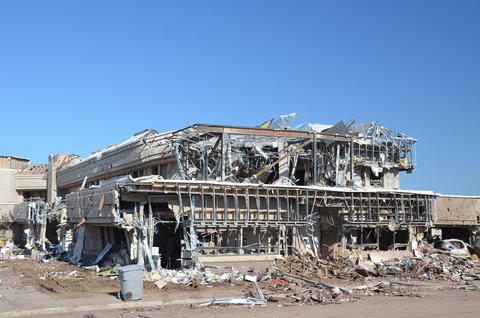NIST Awards $20 Million for Research Center to Help Communities Increase Resilience to Disaster

Moore Medical Center in Oklahoma following the Newcastle-Moore tornado, May 20, 2013.
San Diego—The U.S. Department of Commerce's National Institute of Standards and Technology (NIST) announced today that it has awarded a $20 million cooperative agreement to Colorado State University (CSU) to establish the Community Resilience Center of Excellence. Working with NIST researchers and partners from 10 other universities, the center will develop computer tools to help local governments decide how each can best invest resources intended to lessen the impact of extreme weather and other hazards on buildings and infrastructure and to recover rapidly in their aftermath.
The Fort Collins-based center will receive $4 million annually for five years. NIST has the option to renew the award for five additional years, depending on performance and the availability of funds.
"This center complements NIST's long-standing efforts to improve the performance of the built environment against natural hazards—such as tornadoes, coastal flooding, wildfires and earthquakes—as well as large-scale, human-caused disruptions," said Acting Under Secretary of Commerce for Standards and Technology and Acting NIST Director Willie May. "The tools developed by the center will help to further advance the important goal of disaster resilience from ambitious concepts to cost-effective solutions that communities can implement over time."
Community disaster resilience includes preparing for anticipated hazards, adapting to changing conditions, and withstanding and recovering rapidly from disruptions.
Richard Cavanagh, NIST Acting Associate Director for Laboratory Programs, announced the award at the NIST Disaster Resilience Workshop in Del Mar, Calif. The meeting is the fourth in a series of regional workshops that NIST has convened to gather input from a broad network of stakeholders as the agency drafts its Community Resilience Planning Guide*.
The guide* will provide guidance to communities as they consider pre- and post-event actions and investments to prevent future hazards from inflicting devastating consequences. The guide* focuses on buildings and infrastructure systems, such as power, communication, water and transportation. It also will address how to maintain social services and institutions vital to meeting the needs of community residents, as well as economic functions. Work at the new center will support this sustained effort.
The new center will collaborate with NIST to achieve its long-term goal of developing tools that individual communities can use to assess their resilience. This includes evaluating the effectiveness of alternative measures intended to improve performance and minimize post-disaster disruption and recovery time. These tools will improve decision-making so that communities can build a "business case" for the measures they take.
The centerpiece of the center's effort will be NIST-CORE—the NIST-Community Resilience Modeling Environment. Built on an open-source platform, the computer model and associated software and databases will incorporate a risk-based approach to decision-making that will enable quantitative comparisons of different resilience strategies.
NIST-CORE will provide the scientific basis for developing resilience metrics and decision tools to support the resilience of the built environment and for evaluating cascading effects arising among interconnected infrastructure. In addition, models and tools will integrate social systems vital to the functioning and recovery of communities—health care delivery, education, social services, financial institutions and others.
As NIST-CORE is developed, its performance will be tested against data gathered from past disasters. Ultimately, NIST-CORE will be able to learn from one analysis to the next, a capability that does not exist in any other risk or disaster-resilience model in the world.
John W. van de Lindt, CSU's George T. Abell Distinguished Professor of Infrastructure, serves as the center's principal investigator and co-director. Bruce Ellingwood, CSU professor of civil and environmental engineering, is the other co-director. Associate directors are Paolo Gardoni, associate professor of civil and environmental engineering at the University of Illinois at Urbana-Champaign, and Daniel Cox, professor of civil and construction engineering at Oregon State University.
The center's multi-disciplinary team includes experts in engineering, economics, data and computing, and social sciences from the University of Oklahoma, Rice University, Texas A&M University, the University of Washington, the University of South Alabama, the California Polytechnic University in Pomona and Texas A&M-Kingsville.
As a non-regulatory agency of the U.S. Department of Commerce, NIST promotes U.S. innovation and industrial competitiveness by advancing measurement science, standards and technology in ways that enhance economic security and improve our quality of life. To learn more about NIST, visit www.nist.gov.
* On May 14, 2015, references to the Disaster Resilience Framework in this press release were changed to read Community Resilience Planning Guide to reflect the final name of the document.

